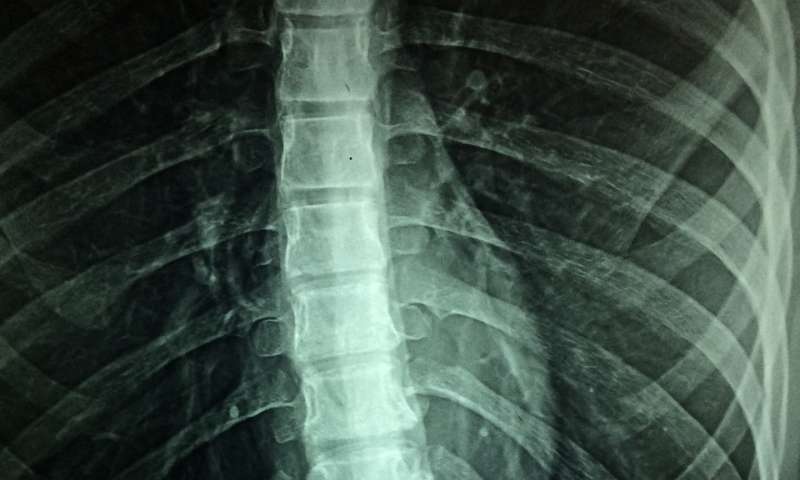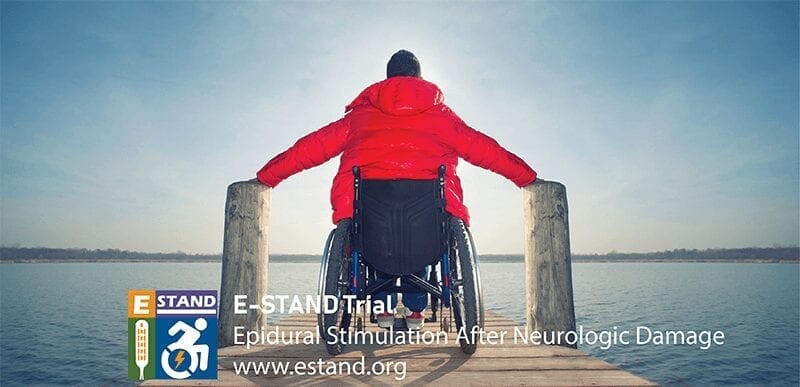
Extended activity-based training with epidural stimulation resulted in ability to stand and move without stimulation
A research participant at the University of Louisville with a complete spinal cord injury, who had lost motor function below the level of the injury, has regained the ability to move his legs voluntarily and stand six years after his injury.
A study published today in Scientific Reports describes the recovery of motor function in a research participant who previously had received long-term activity-based training along with spinal cord epidural stimulation (scES). In the article, senior author Susan Harkema, Ph.D., professor and associate director of the Kentucky Spinal Cord Injury Research Center (KSCIRC) at the University of Louisville, and her colleagues, report that over the course of 34.5 months following the original training, the participant recovered substantial voluntary lower-limb motor control and the ability to stand independently without the use of scES.
“Activity-dependent plasticity can re-establish voluntary control of movement and standing after complete paralysis in humans even years after injury,” Harkema said. “This should open up new opportunities for recovery-based rehabilitation as an agent for recovery, not just learning how to function with compensatory strategies, even for those with the most severe injuries.”
Previous research at KSCIRC involving four participants with chronic clinically motor-complete spinal cord injury found that activity-based training with the use of scES – electrical signals delivered to motor neurons in the spine by an implanted device – allowed the participants to stand and to perform relatively fine voluntary lower limb movements when the scES device was activated. Andrew Meas was one of the four participants in that study.
The original training protocol included daily one-hour activity-based training sessions with the aid of epidural stimulation. During these sessions, the participant trained on standing activity for several months, followed by several months of training on stepping.
After completing a nine-month training program in the lab, Meas continued activity-based stand training at home. After a year of independent training, he returned to the lab to train for three months in a revised activity-based training schedule. The revised training called for two daily one-hour training sessions and included both stand and step training each day, all with the aid of epidural stimulation.
After that training, Meas was able to voluntarily extend his knees and his hip flexion was improved. In addition, using his upper body and minimal additional assistance to reach a standing position, he was able to remain in a standing position without assistance and even stand on one leg, without the use of epidural stimulation.
“We observed that in participants we have worked with so far, eight months of activity-based training with stimulation did not lead to any improvement without stimulation,” said Enrico Rejc, Ph.D., assistant professor in the UofL Department of Neurological Surgery and the article’s first author. “This participant kept training at home and, after several months, he came back to the lab and we tried a different training protocol. After a couple of months of training with the new protocol, we surprisingly observed that he was able to stand without any stimulation – with two legs and with one leg – using only his hands for balance control.”
The authors suggest that several mechanisms may be responsible for Meas’s recovery of mobility, including the sprouting of axons from above the point of injury into areas below the lesion. Another possible explanation may be that the activity-based training with scES promoted remodelling of connections among neurons in the spinal cord.
In addition, they suggest that the participant’s own effort at voluntary movement may have been a factor in the recovery. During the revised training, Meas was attentive and focused on the trained motor task, actively attempting to contribute to the motor output.
“The voluntary component of him trying constantly with spinal stimulation on and while performing motor tasks can lead to unexpected recovery,” Rejc said.
“The human nervous system can recover from severe spinal cord injury even years after injury. In this case, he was implanted with the stimulator four years after his injury. We saw motor recovery two years later—so six years after injury,” Rejc said. “It is commonly believed that one year from injury, you are classified as chronic and it’s likely that you will not improve any more. This data is proof of principle that the human nervous system has much greater recovery capabilities than expected.”
Learn more: Individual with complete spinal cord injury regains voluntary motor function
The Latest on: Spinal cord injury
[google_news title=”” keyword=”spinal cord injury” num_posts=”10″ blurb_length=”0″ show_thumb=”left”]- Wings For Life Funds Promising Spinal Cord Injury Research In New Zealandon May 1, 2024 at 5:01 pm
CatWalk Trust, in collaboration with Wings for Life, is proud to announce a significant grant towards pioneering spinal cord injury (SCI) research led by Dr. Simon O’Carroll, in collaboration with ...
- How Does Spinal Cord Injury Affect Your Health? Learn Moreon April 29, 2024 at 2:27 pm
Despite the fact that Spinal Cord Injury can cause significant health problems such as diabetes or heart disease, a recent study sheds light on how they can compound these problems. A study published ...
- Wings for Life raises awareness and funds for spinal cord injury researchon April 29, 2024 at 10:03 am
The Wings for Life World Run is the World’s largest and most inclusive running event. Anyone can take part, whether you run, roll, jog or walk, regardless of your fitness level, and it’s the only ...
- Does spinal cord injury lead to major health problems? Find outon April 29, 2024 at 9:30 am
A recent study sheds light on how spinal cord injuries can lead to significant health problems like diabetes and heart disease.
- Spinal Cord Injury Damages Metabolism, and Scientists Now Know Whyon April 29, 2024 at 3:40 am
Heart disease and type 2 diabetes are among the leading causes of death in people with a spinal cord injury, researchers explained in background notes. Researchers suspected these disorders might be ...
- Revolutionizing Spinal Injury Treatment: Common Drug Found To Prevent Damage to Fat Tissueon April 27, 2024 at 10:17 pm
Study in mice finds that a widely-used medication prevents damage to fat tissue from injuries A new animal study suggests that conditions like diabetes, heart attacks, and vascular diseases, commonly ...
- Spinal Cord Injury Connection hosts hand cycling event for disabled Oregonianson April 27, 2024 at 5:18 pm
Oregon Spinal Cord Injury Connection held a hand cycling day today, bringing community members with spinal cord injuries out to Blue Heron park for a day of activity and community.
- Neurons Disrupt Metabolism Following Spinal Cord Injuryon April 25, 2024 at 9:40 pm
Researchers discovered in mice that conditions such as diabetes diagnosed in people with spinal cord injuries, can be linked to abnormal post-injury neuronal activity.
- After spinal cord injury, neurons wreak havoc on metabolism: Study finds common drug may prevent some of the effectson April 24, 2024 at 10:14 am
Conditions such as diabetes, heart attack, and vascular diseases commonly diagnosed in people with spinal cord injuries can be traced to abnormal post-injury neuronal activity that causes abdominal ...
- After spinal cord injury, neurons wreak havoc on metabolismon April 23, 2024 at 5:00 pm
Conditions such as diabetes, heart attack and vascular diseases commonly diagnosed in people with spinal cord injuries can be traced to abnormal post-injury neuronal activity that causes abdominal fat ...
via Google News and Bing News










